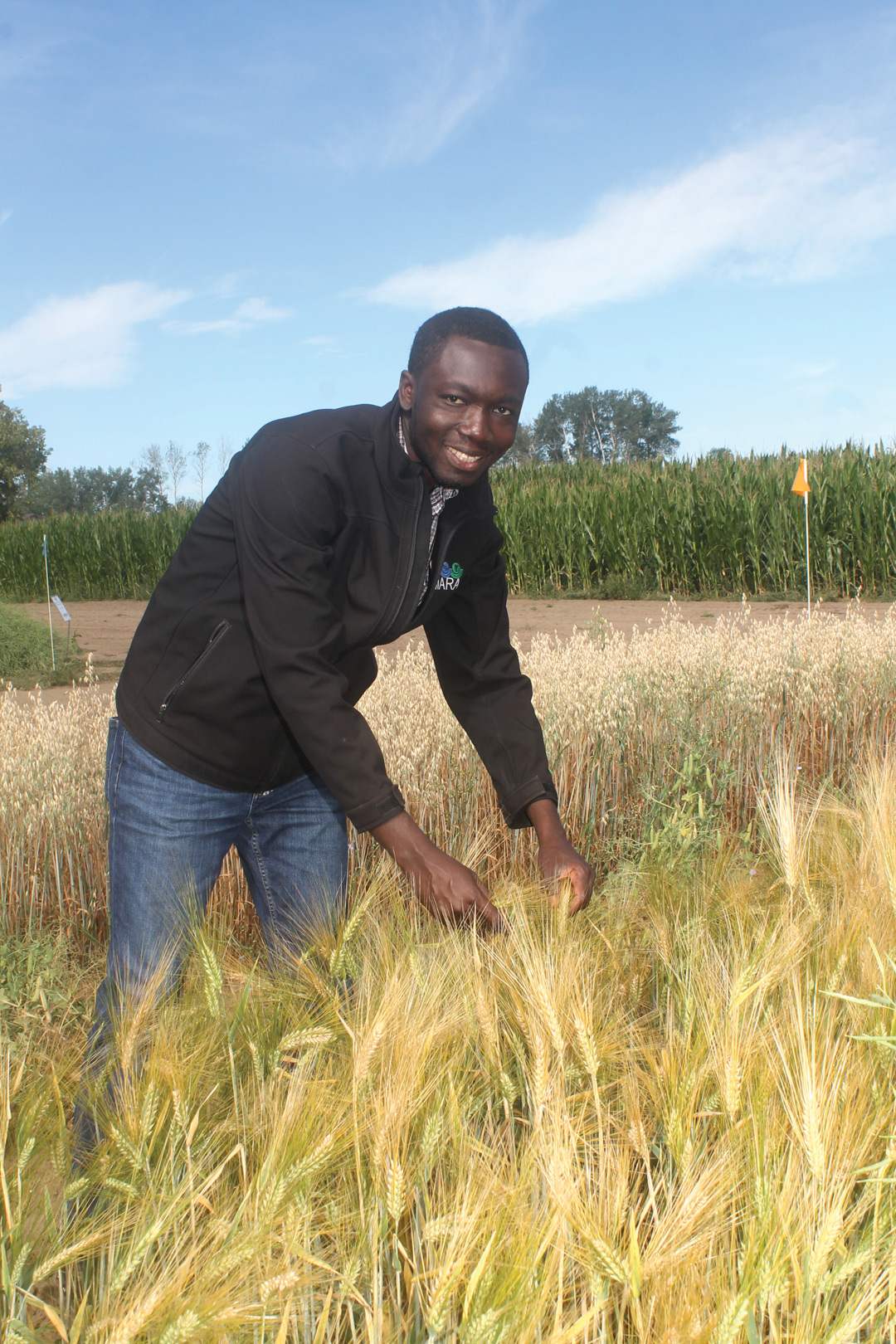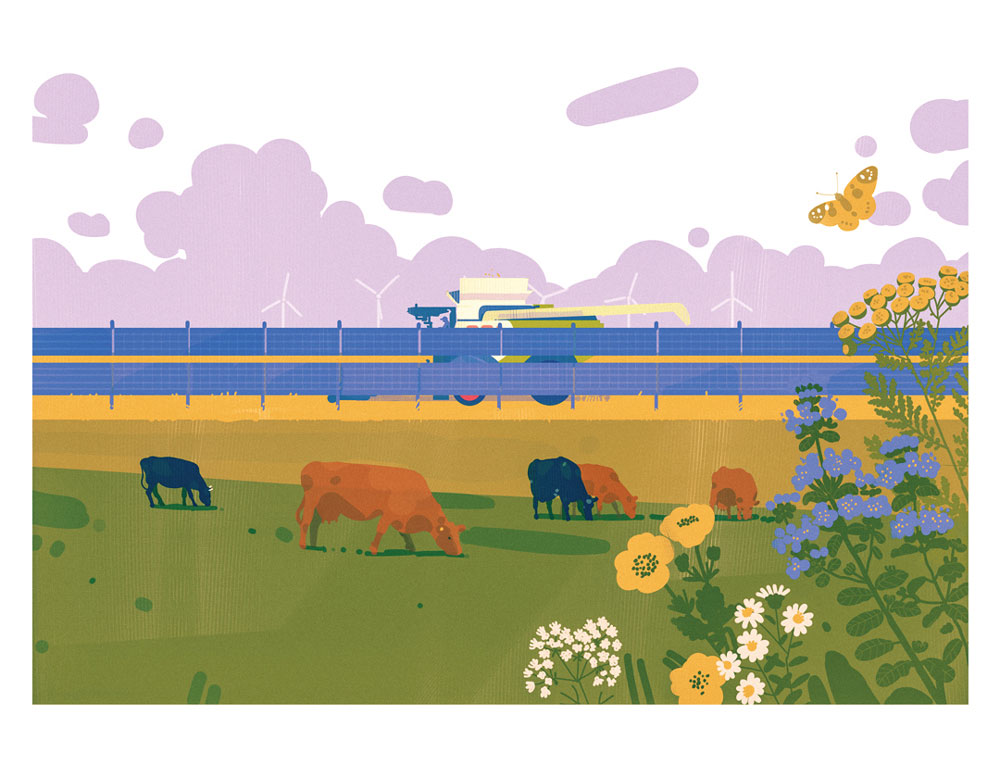NORTHERN FARMERS EMBRACE DATA-DRIVEN SCIENCE
BY IAN DOIG • PHOTO OF MARA’S SAMUEL PEPRAH BY ZOLTAN VARADI
Agricultural research facilities are critical to the forward momentum of Peace Country farming. Established in 1917, the Beaverlodge Research Farm is the most northerly Agriculture and Agri-Food Canada research centre. The wide scope of its programming reflects the sheer size of the region. This encompasses research on forage production and integrated crop management as well as disease and pest management and honey bee pathology.
Jacey Toerper is a master’s student in the facility’s agronomy program. She is at work on one of these many initiatives. The first year of a three-year, ultra-early seeding trial will measure the yield of 10 spring wheat varieties planted at various temperatures. This includes commonly grown varieties as well as early-maturing new and recently commercialized cultivars. “This may be really beneficial for farmers in northern Alberta because we do have the challenge of a shorter growing season,” said Toerper. She hopes farmers share the pride Research Farm staff have in the facility’s work and can employ the agronomic information it produces.
The North Peace Applied Research Station (NPARA) is located in Manning and its companion Research Farm is a short drive away. A non-profit, farmer-driven facility launched in 1988, it serves the County of Northern Lights, Clear Hills County and the Municipal District of Peace No. 135.
The relatively great distance to local elevators combined with an abundance of marginal land has seen mixed operations proliferate here. There are a few existing organic operations with a handful in transition, said NPARA manager Lance Ouellette.
Similar to the rest of the Peace, farmers here have endured multiple very wet years followed by three very dry ones. “It is certainly very challenging when you have extreme weather conditions,” said Ouellette. He added the climate is essentially arid with a frost-free window between 90 and 110 days. Farmers in the Hawk Hills area are particularly aggressive with experimentation, trying biostimulants and humic acids in an attempt to stimulate early plant growth. Interest in soil health and regenerative agriculture is quite high in general, he added. No-till, crop diversification and input cost reduction have experienced a big push.
As at Beaverlodge, NPARA researchers actively search for additional crops and cultivars suitable for the region.
Field trials are underway for CPS and CWRS wheat, fava beans, feed barley, oats, green and yellow peas and forage varieties.
MARA, another not-for-profit, farmer-driven research facility, is located in Fort Vermilion. It’s the organization’s job to pinpoint the challenges faced by farmers in Mackenzie County and to give them objective solutions said Samuel Peprah, MARA manager and research co-ordinator.
This work includes short-season variety trials and research projects that focus on management of weeds, pests and diseases. Also, part of its mandate is the reduction of production costs and preservation of the environment. MARA additionally conducts trials and produces data to quantify the effectiveness of inputs of interest to area farmers who want to know if they work as advertised under local conditions.
Education is also an important element of association work. As NPARA does, MARA has brought in outside experts to speak with farmers about topics such as reduction and prevention of potential disease threats that include Fusarium head blight and sclerotinia.
With a $300,000 grant from the Western Grains Research Foundation and matching funds contributed by farmers, MARA this year established an agronomy centre and repair shop. A much-needed boost to its research and extension activities, it also allowed the launch of a disease mitigation program. Farmers who bring in rental equipment from outside Peace Country can now visit the centre’s decontamination area to have it spray washed and sanitized. Peprah believes this will help keep Mackenzie County free of clubroot.
To the predominant local crop list of barley, canola, fava beans, peas and wheat, MARA works to build the agronomic cases for crops such as triticale, corn, flax and, most surprisingly, soybeans. Perhaps also unexpected, 41 per cent of farmers in the county are organic. Virgin land is still being converted to this type of agriculture. Organic systems research is naturally a part of MARA programming.
An area of opportunity for northern farmers in the future is irrigation, said Peprah. Certain farmers now haul water from the Peace River for their crop needs. Many here may be interested in pivot irrigation systems if crop commissions and government programs to aid in their set up are ever launched.
“The rule of the game for farmers in the Peace Region is evidence. They want to see it,” said Peprah. It’s an impulse that snowballs. The more you know, the more you want to know. “As they learn and make gradual changes, farmers become more progressive, forward thinkers.” He emphasized the research facilities in Peace Country have opened farmers’ eyes to the positive effects data-driven science can have on their operations.







Comments